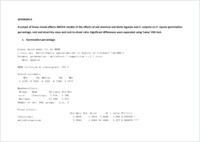Re-establishment of Protea repens after clearing invasive Acacia saligna: Consequences of soil legacy effects and a native nitrophilic weedy species
- Nsikani, M. M. Centre for Invasion Biology, Department of Botany and Zoology, Stellenbosch University, Matieland, South Africa
- Wilgen, B. W. van Centre for Invasion Biology, Department of Botany and Zoology, Stellenbosch University, Matieland, South Africa
- Bacher, Sven Centre for Invasion Biology, Department of Botany and Zoology, Stellenbosch University, Matieland, South Africa - Department of Biology, Ecology and Evolution Unit, University of Fribourg, Switzerland
- Gaertnera, M. Invasive Species Unit, Environmental Resource Management Department, City of Cape Town, Westlake Conservation Office, Tokai, South Africa - Nürtingen-Geislingen University of Applied Sciences (HFWU), Nürtingen, Germany
-
01.05.2018
Published in:
- South African Journal of Botany. - 2018, vol. 116, p. 103–109
English
Invasive Australian acacias can alter soil chemistry and microbial communities in areas they invade. After clearing invasive acacias, these changes can persist, and previously invaded areas can become dominated by nitrophilic weedy species. Restoration of viable native plant communities in cleared sites often fails due to a lack of native species re-establishment. Therefore, to improve restoration outcomes, it is important to understand the effects of soil chemical and biotic legacies, and of nitrophilic weedy species, on native species re-establishment. To investigate the effect of soil chemical legacies, we germinated and grew Protea repens seedlings (a native proteoid shrub) as an indicator species in soil taken from areas cleared of Acacia saligna in lowland fynbos, as well as from non-invaded areas under controlled conditions. To investigate the effect of soil biotic legacies, we sterilized half the soil from each cleared or non-invaded area. We grew Ehrharta calycina (a native nitrophilic weedy grass species) in half of each treatment and measured the effect of treatments on P. repens germination and growth. Germination percentage, root and shoot dry mass of P. repens did not significantly differ between altered and native soil chemistry. The germination percentage of P. repens was significantly greater (93%) in the presence of soil microbial communities than in their absence. The presence of E. calycina significantly increased (29%) the root-to-shoot ratio of P. repens than their absence. Since the legacy of altered soil chemistry did not have a direct negative effect on P. repens germination and growth; we conclude that restoration efforts do not always have to manage altered soil chemistry after clearing invasive A. saligna.
- Faculty
- Faculté des sciences et de médecine
- Department
- Département de Biologie
- Language
-
- English
- Classification
- Biological sciences
- License
-
License undefined
- Identifiers
-
- RERO DOC 322801
- DOI 10.1016/j.sajb.2018.02.396
- Persistent URL
- https://folia.unifr.ch/unifr/documents/307322
Other files
Statistics
Document views: 82
File downloads:
- pdf: 235
- Supplementary material: 201

